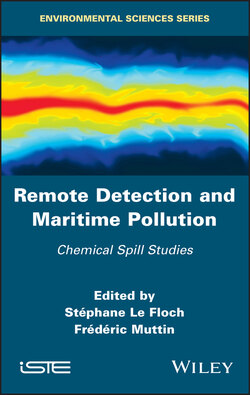Читать книгу Remote Detection and Maritime Pollution - Группа авторов - Страница 20
1.3.2. Evaluation of radar, optical and hyperspectral sensors at sea 1.3.2.1. General presentation of the experiment
ОглавлениеThe experimentation took place in May 2015 over the French coast in the Mediterranean Sea at two locations: 42°46.8’N/6°2.0’E for the first release and 42°45.5’N/5°48.5’E for the second and third releases. One cubic meter of each of the six chemical products (presented in section 1.2.2) was released at sea and imaged by radar and optical airborne sensors for their evaluation in real conditions.
HNS releases were performed from the salvage, rescue and oil spill response vessel Ailette of the French Navy under the direction of CEPPOL (Centre of Practical Expertise in Pollution Response) and CEDRE. Each chemical product was contained in a one cubic-meter tank, in HDPE (High Density PolyEthylene) for non-aggressive HNS (rapeseed oil, FAME and methanol) and in metal for reactive or corrosive HNS (xylene, heptane and toluene). Each tank was inserted in a metallic structure equipped with two 220 L floaters to ensure the floatability of the system and a lifting strap to manipulate the tanks with the onboard crane (Figure 1.2). The release of the HNS was performed from a dinghy by pulling a rope that activates the opening of the tank. Due to the difference in density between seawater and HNS, the chemicals spread at the sea surface.
In order to follow the drifts of the HNS slicks, two drifting buoys were implemented. Their GPS positions were transmitted by satellite every 15 minutes.
Figure 1.2. One cubic-meter tank. (a) HDPE. (b) Metal
Three aircraft imaged the HNS slicks:
– a Falcon 20 from AVdef company equipped with the experimental pod SETHI, including the ONERA sensors: two radars (SAR) at X and L bands, full polarization (HH, HV, VH, VV), one SWIR hyperspectral camera (HYSPEX), one CamV2 camera (visible range);
– a POLMAR aircraft from DGDDI equipped with IR sensor, UV sensor and SLAR radar at X-band;
– a Cessna C-303 chartered by DRDC equipped with an IR hyperspectral camera (TELOPS).
On board the Ailette, two optical cameras were installed by DRDC: a MWIR hyperspectral camera and a Bomem MR304 LWIR and MWIR spectroradiometer.
In order to characterize the behavior of HNS once released at sea (evaporation, dissolution, emulsification, etc.), sampling of the slicks, the water column and the atmosphere were planned.
